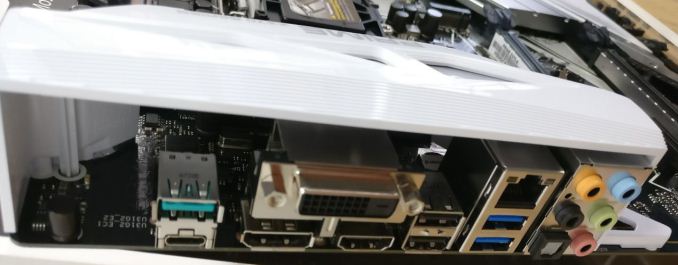Analyzing Z370 for Intel's 8th Generation Coffee Lake: A Quick Look at 50+ Motherboards
by Ian Cutress, Anton Shilov, Joe Shields & Gavin Bonshor on October 20, 2017 2:00 PM ESTASUS PRIME Z370-A
The ASUS Prime Z370-A has some of ASUS' classic mainstream look without offering some of the exotic PCB stylings that other products have. The Prime boards are typically a driving platform for the subtle inclusion of customizable RGB lighting, starting with the top right-hand side of the motherboard area with additional RGB headers, but users looking for something black and white (literally) can turn this off via the BIOS or the ASUS AURA SYNC software utility.
The Prime Z370-A uses three full-length PCIe 3.0 x16 slots, with the top two having SafeSlot reinforcement and run at x16 or x8/x8 with two GPUs. The final bottom full-length slot, as well as the four PCIe 3.0 x1 slots, take their lanes directly from the chipset. Both SLI and Crossfire configurations are supported. The board supports two memory modules per channel, with an on-box rated speed up to DDR4-4000 (depending on the performance of the memory controller on the processor). ASUS likes to promote its T-Topology technology for their high-speed memory support.
The black PCB features plenty of triangle shaped white imprints on the PCB (which I believe detracts from the cleanness of the build), but the Prime Z370-A does drop most of the gaming-related specifics such as SupremeFX audio that the Strix and Maximus X boards use. The audio is the same Realtek ALC1220 codec, except this time the Crystal Sound 3 branding is present.
On the rear IO panel we find a pair of USB 3.1 10Gbps ports (one Type-A and one Type-C) with a further two Type-A USB 3.1 5Gbps and two USB 2.0 ports on the back. The front panel headers on this board allow for an additional four USB 3.1 5Gbps ports and four USB 2.0 ports in total. The Prime Z370-A is another adopter of the Intel I219-V gigabit Ethernet controller and Realtek ALC1220 codec, with an EMI shielded codec using gold Nichon audio capacitors. For the rear IO this means 3.5mm audio jacks and a single S/PDIF output. Video outputs come from a DisplayPort, HDMI and DVI-D port.
For storage, the chipset heatsink hides one of the M.2 slots underneath which also aids in high-performance storage cooling. The top M.2 slot is placed alongside the top PCIe x1, and just above the most northerly placed full-length PCIe 3.0 x16 slot. The Prime Z370-A has a total of six SATA ports as well.
The Prime Z370-A offers ones of the most loaded cooling option header clusters from any ASUS boards in the sub $200 price point. On top of the AIO and thermal sensor headers, there are five 4-pin PWM headers.
The focus on the Prime Z370-A is for consumers that want a clean and clear board with the option of subtle RGB lighting thanks to a single RGB strip header, or a simple white and black contrasting theme is possible. It keeps a lot of the top features and components of the Strix range, but with a lower emphasis on gaming and more focus on traditional use.













83 Comments
View All Comments
tommythorn - Monday, October 23, 2017 - link
While that feature page is great, the thunderbolt part is slightly misleading as a few of them supports it via an add-in-card. The page only lists the one that has it built-in. (The lackluster support for TB3 as well as 10 GbE is disappointing).OFelix - Saturday, October 21, 2017 - link
ThanksStochastic - Friday, October 20, 2017 - link
Would you consider putting out some simple Wirecutter-style recommendations? A lot of people (including myself) would like someone else who is better informed to simplify the decision-making process.Ian Cutress - Friday, October 20, 2017 - link
When we get our Z370 reviews underway, we'll start doing some buyers guidesStochastic - Friday, October 20, 2017 - link
Great, thanks!IGTrading - Sunday, October 22, 2017 - link
When do we get a 50+ AMD motherboard article guys ? :)abrowne1993 - Friday, October 20, 2017 - link
Okay but which one looks the coolest?dave_the_nerd - Friday, October 20, 2017 - link
"Whoever thought this was a good idea at Intel needs to be fired."Well... gee... why don't you tell us how you really feel?
DigitalFreak - Friday, October 20, 2017 - link
This whole notch thing makes me wonder if the 8xxx series was originally supposed to work in existing motherboards, but Intel ran into issues at the last minute.KaarlisK - Saturday, October 21, 2017 - link
Honestly, I cannot see the issue. The pins were changed so that nothing bad will happen if you put the wrong CPU in the wrong motherboard.As for the notches, I for one am happy that they were not changed. This means they can reuse the physical design, which lowers validation costs, which makes the CPUs cheaper.